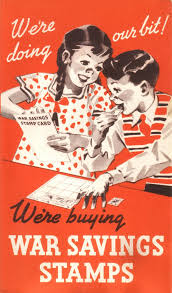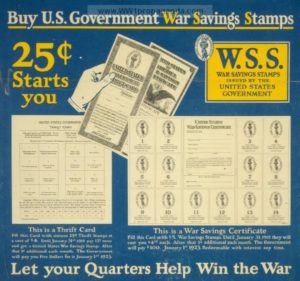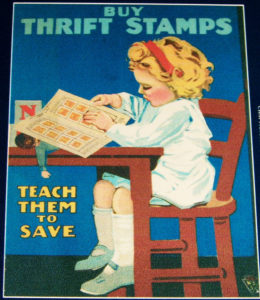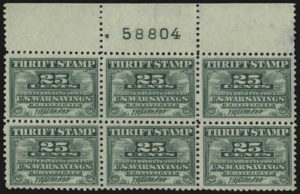“Two dimes and a nickle may make but a
But war Thrift Stamps put the Kaiser in a pickle. Salt him down.”
During World War I, war expenses totaled $33 billion, and the Treasury Department sold approximately $21 billion worth of Liberty Bonds to meet the nation’s new financial demands. Edwards County citizens showed strong support in their purchase of Liberty Bonds, but not everyone had $50 to buy one. On January 1, 1918, the treasury department began another way that even the poorest citizens and the children could give patriotic support. They developed an installment plan which also fostered the traditional value of saving. The Kinsley School system enthusiastically embraced this plan which was explained in the January 17, 1918 issue of the Kinsley Graphic,
“The Thrift Stamp movement inaugurated by the government is getting hold of the pupils in our schools. Teachers are stimulating their pupils in healthy rivalry with other rooms in this matter. At the present Miss Folger’s room is ahead. The stamps are kept in the office, and pupils are buying them every day. As soon as one of the Thrift Cards is filled (it holds sixteen Thrift Stamps) the pupil takes it and twelve cents to the postoffice or to one of the banks and gets a Baby Bond.”

 Once 10 Baby Bonds were collected, they could then be exchanged for a $50 Liberty Bond. Baby Bonds, like Liberty Bonds, drew interest. The campaign began on 2 January 1918 and closed at the year’s end. When the War Savings Stamps matured on 1 January 1923, the Treasury Department promised to pay the sum of five dollars for each certificate. In little more than a year over $1 billion was raised in this campaign, fulfilling its ideological and financial purposes
Once 10 Baby Bonds were collected, they could then be exchanged for a $50 Liberty Bond. Baby Bonds, like Liberty Bonds, drew interest. The campaign began on 2 January 1918 and closed at the year’s end. When the War Savings Stamps matured on 1 January 1923, the Treasury Department promised to pay the sum of five dollars for each certificate. In little more than a year over $1 billion was raised in this campaign, fulfilling its ideological and financial purposes
The February 21, 1918 issue of the Graphic made another plea.
“Can children be taught to save? They certainly can, and this is one of the greatest lessons that childhood and youth need to be taught. It may be a little difficult under ordinary conditions to inculcate in our youth the principles of thrift, but during these stenuous war times it will not require much effort if the advantages of saving are kept continually before our boys and girls.
The schools of our city are making a great effort to build up the habit of savng, while at the same time they are helping the government in a patriotic way. On Saturday, the 2nd of this month, Mr. Baugher compiled a list of thrift stamps and baby bonds held now by the different schoolrooms of the city. It was found that 129 baby bonds and 384 thrift stamps are now owned. This is an excellent showing, but we hope that our young people have only made a beginning. The pupils ought to be buying thrift stamps every day. The teachers are boosting this movement all they can. Every parent is urged to help. Teach the children thrift.”

 It’s interesting that in recent conflicts neither the general public nor the children have been called on to sacrifice or support our military to such an extent.
It’s interesting that in recent conflicts neither the general public nor the children have been called on to sacrifice or support our military to such an extent.
